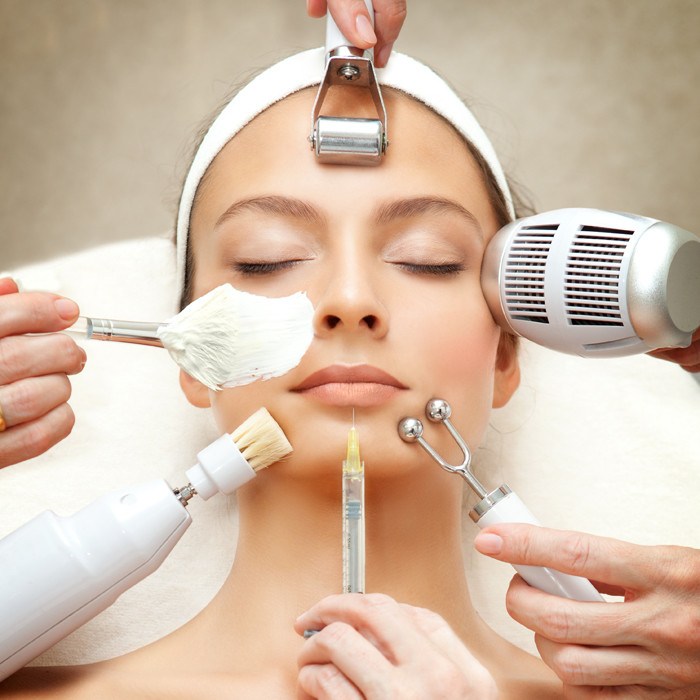The Latest in Noninvasive Facial Rejuvenation

With scientists working overtime to advance virtual reality, gene editing, artificial intelligence, 3D printing and much more, it’s a shame for aging faces everywhere that they still haven’t prototyped a time machine. Not only are skincare pros offering boosters and device-driven techniques that nip photodamage, wrinkles and sagging skin in the bud, but even cosmetic surgeons recommend comprehensive topical skin care as an integral way to maximize facelifts’ results.
But facial surgery’s postprocedure downtime and potential for long-term side effects is driving many aesthetic consumers toward noninvasive, time-erasing alternatives. Here, DAYSPA presents the latest and greatest ways you can help guests frolic in the fountain of youth—without going under the knife.
Equip Yourself
Clients seeking alternatives to facelifts will probably first want to hear about noninvasive devices to help reverse-engineer sagging, facilitate self-generation of youthful proteins like collagen and elastin, and smooth wrinkles. Remind clients that most of the below treatments work best in a series of four to eight, with occasional maintenance services thereafter.
To start, there’s microcurrent, which generates small amounts of pulsated electricity that mirrors the body’s natural current. As Francois Requier, general manager of Silhouet-Tone, puts it, “Microcurrent treatments stimulate facial muscles and firm, lift and tone them.”
Another common lifting treatment employs radiofrequency (RF) waves, typically delivered via an electrode. RF produces a localized heat injury, as well as collagen contraction, within the dermal and subdermal layers of the skin—all of which has a tightening effect. And then there’s electroporation, a technology that generates an electrical current that opens a pathway into the skin, allowing for deeper product penetration.
Light therapy is another option for clients seeking to keep Father Time at bay. Most estheticians are well aware that red LED light reduces fine lines and wrinkles, and that blue helps treat acne and inflammation.
But a new entry in the category is Silhouet-Tone’s Lightfusion, which harnesses various types and wavelengths of light energy to promote collagen synthesis and improve blood flow. “Lightfusion’s specific wavelengths energize dull, tired skin cells that have been compromised due to aging,” says Requier. “Used in conjunction with topicals, it stimulates cellular processes below the skin, ultimately improving firmness and reducing fine lines, wrinkles and pigmentation.”
Also effective? Temperature. While thermal energy is believed to warm skin’s inner layers, promoting blood and lymph circulation—which can rejuvenate puffy eyes anddark circles—cryotherapy, or cold treatment, is helpful for locking in skin’s natural moisture and hastening the recovery of wounded epidermal cells. For a heat/light combo platter, look no further than microphototherapy, which creates a mild thermal injury beneath the skin’s surface, leading to fibroblast production and thus, the formation of new collagen.
Hand It to Your Clients
As they say, a facial massage a day keeps the cosmetic surgeon away. To help naturally tone facial muscles, tighten loose skin and brighten the complexion, spa pros are increasingly incorporating manual protocols into their services.
Brian Goodwin, an international trainer for Éminence, recommends a jaw lymph drain and collagen stimulating technique, which he says allows the esthetician to tighten, energize and tone the skin, “particularly along the jawline, which starts to lose elasticity with time. The thumb moves in rocking motions, beginning from the center of the chin, moving toward the ear while intersecting the opposite hand’s thumb and index finger with each motion,” he explains. “This massage motion creates friction for collagen stimulation, while assisting with lymphatic drainage to remove toxins.”
Topical Assist
To maintain the lift clients get in the spa while improving skin’s long-term health, an effective daily homecare regimen is crucial. Charlene DeHaven, MD, clinical director of Innovate Skincare, emphasizes that topicals provide a source of “nutritional building blocks” that assist in treating aging skin.
She points to growth factors first. “
Growth factors and cellular messengers called cytokines increase collagen and boost the skin metabolism needed for youthful complexions,” she says. “Skin care containing vitamins and antioxidants will help maintain that metabolism, preventing the sallowness and loss of vitality that accompanies aging.”
Remember, free radical damage occurs continuously over many years, which is why it’s so important to maintain a consistent topical antioxidant regimen. Consider combining them (especially photodamage-combating vitamin C) with humectant hyaluronic acid to soften lines and wrinkles. Topical vitamin A—which exfoliates and improves cellular function—is also highly recommended.
No discussion of antiaging ingredients is complete without “nature’s Botox,” aka peptides. Created from a blend of amino acids, these proteins send signals that alert skin cells to produce more collagen. Applying products containing peptides can in fact “trick” skin into thinking its collagen is diminishing and cause it to produce more.
Peptides mix well with botanical stem cells. Éminence’s Goodwin explains that stem cells are the “master cells” that allow the body to produce new cells and repair itself. “Plant stem cells, tho
ugh different from our own, contain enough of the same factors to temporarily replenish damaged factors that increase as we age—and as our skin is exposed to free radicals, sun and pollutants—allowing the cells to function more like younger cells, and boosting cell turnover rates and elastin production.”
Whatever skin care you recommend, make sure your clients understand that, unlike cosmetic surgery, topicals require regular, consistent use.
 The Injection Question
The Injection Question
Not all spas are allowed to administer filler and neurotoxin injections such as Juvéderm and Botox, but many clients today regard injectables as mainstays
of antiaging treatments. However, when used alone, they provide architectural support only, cautions Charlene DeHaven, MD, clinical director of Innovative Skincare. “They don’t improve skin health or return youthful glow,” she says. “When looking at a face treated only with injectables, there often seems to be something missing. A truly youthful appearance requires topicals.” Fillers may be popular, but Tina Nguyen, national education and sales specialist for Dermatude, notes that, “The more clients receive injectables plus devices, the less they will need to continue the injectables.”
Team Rejuvee